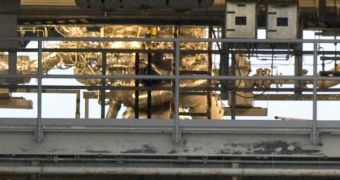The space launchers expected to take astronauts and cargo to the International Space Station by 2015 and to carry a manned mission to the Moon and Mars by 2020, as part of NASA's Constellation Program, have completed on Thursday their first series of tests in the early development program. The Ares I rocket along with the Orion capsules are set to replace the old US orbiters that will end their service in 2010. For a period of five years, until 2015, the US will have no personal means of space transportation. The Ares V rocket, also in development, is designed only for cargo and component transportation.
Both the Ares I and V launchers will be equipped with J-2X engines, based on the heritage J-2 engines, which were part of the Apollo and X-33 programs, and will use hydrogen fuel as main combustible to produce thrust. Prior to the test that took place on Thursday, NASA carried out nine separate tests to verify the performance data and to explore the performance boundaries of the heritage J-2 components.
"This series of tests is an important step in development of the J-2X engine. We started with a number of objectives and questions we needed answers to as we work to complete designs of the J-2X engine. The data we have gained will be invaluable as we continue the design process", said Mike Kynard, manager of the upper stage engine for the Ares Projects at NASA's Marshall Space Flight Center.
The tests conducted at NASA's Stennis Space Center have the role of improving the performance of the J-2X pumps and of other components based on this design. The J-2 engines designed for the Apollo program, which put the first man on the Moon, are capable of producing approximately 104,545.5 kilograms of thrust while the new J-2X design is expected to output at least 133,636.4 kilograms of thrust.
The most crucial investigations that are currently drawing the attention of NASA engineers involve resolving the differences between the turbopump of the old engine design and those of the newly tested components, as well as the vibrations and pressure drops in the turbopump inlet ducts. According to the results of the tests, the J-2X engines were run at a power of 124,545.5 kilograms of thrust for up to 400 seconds.
Once the data of the first test series is being reviewed and meets the objectives, the second series of tests should be carried out. Although the J-2X engines of the upper stages are being managed by the Marshall Space Center, they were in fact designed, built, tested and evaluated by the Pratt and Whitney Rocketdyne Inc. under a contract awarded by NASA in the middle of last year.

 14 DAY TRIAL //
14 DAY TRIAL //